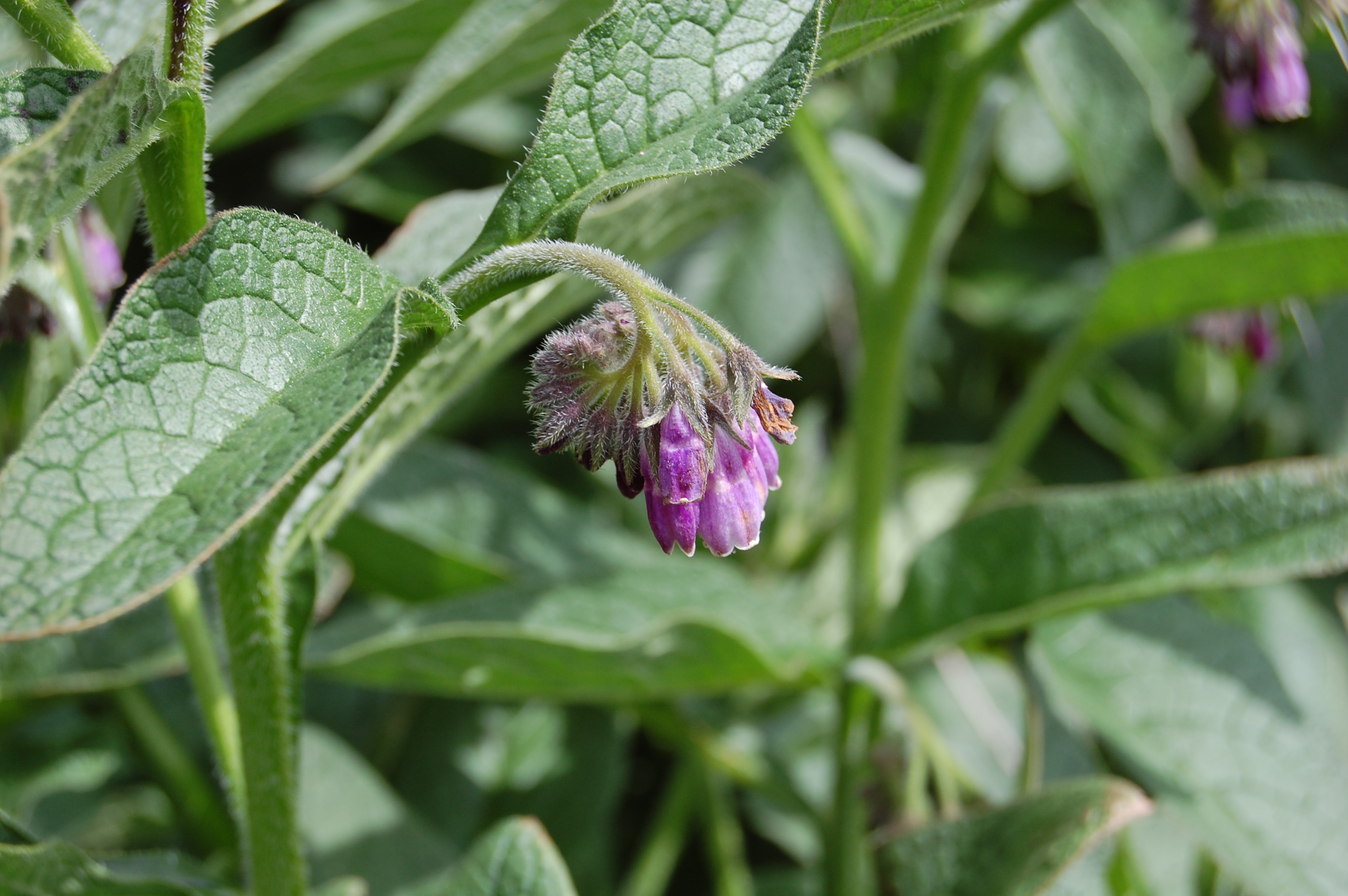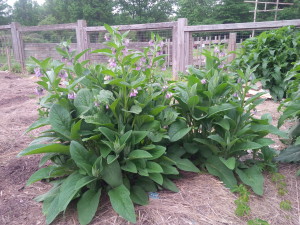A clump of comfrey (Symphytum officinale) is an organic gardener’s best friend. This useful herb is a repository of nutrients and minerals that can be used to fertilize your garden.
Comfrey is a perennial herb in the same family as borage. Like borage, it has hairy leaves so gloves should be worn when handling it. Comfrey flowers are downward facing bells like borage flowers and range in color from lavender to cream. The plants are very large, easily reaching 5 feet in height and up to 4 feet in width with leaves 12 to 18 inches in length. Comfrey has a long tap root, making it drought resistant. It grows best when well-watered, however. Thanks to that long tap root, it can be very difficult to get rid of once the plant becomes established. Any pieces of root left behind will grow another plant. The seeds are sterile in the variety most commonly used so it won’t self-sow in the garden. Neither does it have runners like tansy so comfrey will not take over your garden. The plants grow rapidly and should be divided every 3 to 4 years. Division is easy. Just take a shovel and drive it through the crown to make your divisions. Plant the pieces at least three feet apart. Comfrey grows best in full sun but will tolerate a little shade.
What makes comfrey so valuable to organic gardeners is its long tap root, non-fibrous leaves and fast growth. The tap root grows deeper in the soil than most plants so it can access minerals and nutrients not available to other plants. Those minerals and nutrients are stored in the leaves, which lacking fiber, break down easily and can be used in a compost tea for your plants, as a compost activator, as a mulch and as part of your potting mixture for containers. The fast growth of the plant allows it to be harvested every 5 weeks during the growing season.
Harvesting can begin when your comfrey plants are at least 2 feet high. Using gardening shears, a scythe or a sickle, cut the plants down to two inches above the soil. Within weeks, the plants will have grown back and be ready to be harvested again. You can continue harvesting your plants until fall when it is best to allow them to build up their winter reserves of nutrients. The plants die back completely in the winter and those nutrients flow back into the roots where they are stored until needed in the spring for the plant to begin growing again.
In the past, comfrey was used medicinally but is now considered poisonous when used internally. It contains pyrrolizidine alkaloids which can build up in the liver over time eventually causing damage and even death.
If you are an organic gardener and inveterate composter like me, a patch of comfrey is a must-have. It is well-behaved, staying in the part of the garden where you have planted it but increasing in size each year so that you can divide your plants and expand your comfrey patch or share some with friends.



22 Comments on “Comfrey”
Tell me more about Comfrey. I used to grow it but long time back. I want the best source/quality for herbal/medicinal purpose. Please give be info and price/size/seed or root stock…..etc.
I do not sell or promote sources for herbs. This website is about how to grow herbs.
Thank you for this information about comfrey! I planted a small plant last fall and it has thrived (getting huge over the summer!) but in the last few weeks it has died back to nothing. I live in zone 7 and we have yet to have a hard freeze, and there haven’t been any droughts or other harsh condiditons. The base of the plant is a bit slimy in places. I have been searching for a possible cause, but can’t find any info on what could have caused it. Could this just be normal die back? Thank you again for your site and the info you provide!
My guess would be that the plant is doing its normal fall die back. We have had an abnormally cold fall so plants are dying back early. Just remove any dead or dying foliage. The plant should come back with no problem in the spring.
Thanks for the reply!! I hope you are right! I enjoyed using its leaves in slaves and as compost for the garden this summer and was/am looking forward to long happy relationship 🙂
Thanks again for the info!
Slaves = salads? If so, then I would strongly urge you to stop eating it. As stated in my article: “Comfrey used to be used medicinally but is now considered poisonous when used internally. It contains pyrrolizidine alkaloids which can build up in the liver over time eventually causing damage and even death.”
Salves was correct! I made an infused oil with the leaves then added melted beeswax to make it a salve. We use it on minor cuts, scrapes and bruises 🙂 it works wonderfully!
Sorry! I realized later that you probably meant salves which are fine with comfrey.
Just noticed the “slaves” typo 🙂
me and my sister have had comfrey which we love but it takes over everywhere and is hard to control!!
I just have started researching compared and notice that there seems to be some confusion between compared and borage. Can you give me guidelines as to how to tell them apart? I have something growing that I did not plant. The flowers look like the ones of compared, but a neighbor said it was borage.
Borage and comfrey are easy to tell apart. Borage has blue star shaped flowers, hairy light green/grayish leaves and is an annual. Comfrey has purple bell shaped flowers, dark green leaves and is a perennial.
Auto correct changed “comfrey” to “compared”. Sorry I didn’t catch it before I sent my question.
I planted one borage a few years ago and now have hundreds of seedlings that pop up every year in one raised bed. The bees seem to love the flowers. How would you recommend controlling the borage while at the same time leaving enough for the bees to enjoy?
Remove most of the flowers before they produce seed. Leave just a few so that you don’t have as many seedlings the following year.
Curious about why someone would choose to put comfrey in their garden vs borage. Everything I’ve read talks about them having similar uses and benefits. I know that borage is an annual. Anything else that would cause someone to pick one over the other?
Borage is good for repelling pests and attracting beneficial insects. Plus it is edible. Comfrey is used to add nutrients to the soil thanks to its long taproot. It is not edible. I advocate using both in vegetable gardens because they provide two different benefits.
I’ve heard about it being used topically, for joints/muscles and such. Do you have any more info on this?
No, I don’t. I am not an herbalist.
Comfrey is edible and is actually cultivates for food in parts of Kenya where I’m from I was pleasantly surprised to find them growing plentifully in the wild here in the UK. they can be treated the same as spinach, kale or pumpkin leaves.
I simmered my comfrey for 3 hrs and my jars did not come in today, can i leave it in the comfrey and in the jar after simmering for a week more Gayle
I would refrigerate it until your jars come.